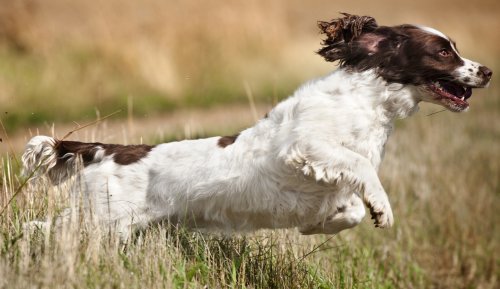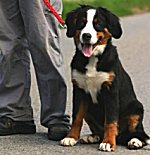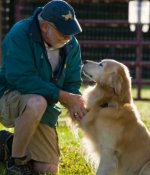English Springer Spaniels: What's Good About 'Em, What's Bad About 'Em
English Springer Spaniel temperament, personality, training, behavior, pros and cons, advice, and information, by Michele Welton, Dog Trainer, Behavioral Consultant, Author of 15 Dog Books

This high-spirited tail-wagger needs at least one long vigorous run every day. Without exercise an English Springer Spaniel can be a boisterous handful, especially when young.
His opinion of strangers varies from friendly to reserved. Most are good watchdogs, but not guardians.
Caution: There is serious dominance/aggression lurking in the background of some lines. Early socialization and stable parents are essential in this breed.
Most English Springers are gregarious with other animals, though there is some same-sex aggression.
Some individuals can be so persistently affectionate that they become clingy, which can result in separation anxiety and destructiveness when left alone.
Many Springers love getting into puddles and water bowls and tracking mud through the house. This is not a dainty breed, nor one for fastidious housekeepers.
If you want a dog who...
- Is medium-sized and sturdy
- Has a pretty feathered coat in a variety of colors
- Thrives on vigorous athletic activities
- Has a tail-wagging nature
- Is usually polite with everyone
- Is usually peaceful with other pets
An English Springer Spaniel may be right for you.
If you don't want to deal with...
- Providing enough exercise to keep him satisfied and avoid rambunctiousness
- "Separation anxiety" (destructiveness and barking) when left alone too much
- Frightening dominance/aggression that can suddenly flare up in some Springers
- Fearfulness or shyness when not socialized enough
- Frequent brushing, combing, and clipping of the silky coat
- Shedding
- Excitable or submissive urination (tendency to dribble urine when excited or nervous)
- Serious health problems
An English Springer Spaniel may not be right for you.
 |
Dog Breed Traits – Which Traits Are Right For You? In this brand new series, I'll help you decide which dog breed traits would best suit you and your family, your home and yard, and your lifestyle, so you can choose the best dog breed for your family. |
Keep in mind that the inheritance of temperament is less predictable than the inheritance of physical traits such as size or shedding. Temperament and behavior are also shaped by raising and training.
FREE eBooks by Michele Welton
![]() "Respect Training for Puppies" and "Teach Your Dog 100 English Words" are free step by step guides to teaching your pup to be calm and well-behaved.
"Respect Training for Puppies" and "Teach Your Dog 100 English Words" are free step by step guides to teaching your pup to be calm and well-behaved.
![]() "11 Things You Must Do Right To Keep Your Dog Healthy and Happy" is a free guide to keeping your dog mentally, physically, and emotionally happy and healthy so you can enjoy a longer lifetime of companionship.
"11 Things You Must Do Right To Keep Your Dog Healthy and Happy" is a free guide to keeping your dog mentally, physically, and emotionally happy and healthy so you can enjoy a longer lifetime of companionship.

- You can avoid some negative traits by choosing an ADULT dog from an animal shelter or rescue group. With an adult dog, you can easily see what you're getting, and plenty of adult Springers have already proven themselves not to have negative characteristics.
- If you want a puppy, you can avoid some negative traits by choosing the right breeder and the right puppy.
More traits and characteristics of the English Springer Spaniel
If I was considering an English Springer Spaniel, I would be most concerned about...
- Providing enough exercise and mental stimulation. English Springer Spaniels need regular opportunities to vent their energy and do interesting things. Otherwise they will become rambunctious and bored, which they usually express by barking and destructive chewing.

- Potential separation anxiety. All of the spaniel breeds need a great deal of companionship and do not like being left alone for more than a few hours. They tend to express their unhappiness through destructive chewing and barking.
- Providing enough socialization. English Springer Spaniels need extensive exposure to people and to unusual sights and sounds. Obedience instructors see too many English Springers who are fearful, suspicious, occasionally even aggressive. Sometimes this is from poor socialization – but sometimes a bad temperament is inherited.
So be very careful when you're looking for an English Springer Spaniel. Neither socialization nor training can change a genetically bad temperament.
- Grooming. Coat care is a big responsibility when you own a Springer. Especially an individual from show lines, since these dogs tend to have heavy coats with lots of feathering. Just think of all the mats and tangles that can form! You ward those off by catching them early, with weekly brushing and combing. Every couple of months, you (or a groomer) need to trim and clip the coat to keep it neat and sanitary.
- Shedding. Expect a lot!
- Potential health problems. From hip problems to eye problems to metabolic diseases, English Springer Spaniels are risky in the health department. See English Springer Health. Of particular concern is a rare neurological disorder that causes sudden flare-ups of extreme dominance or aggression. The cause is unknown, though research suggests a link to brain seizures.
My best-selling books – now available FREE on my website
 Respect Training For Puppies: 30 seconds to a calm, polite, well-behaved puppy is for puppies 2 to 18 months old. Your puppy will learn the 21 skills that all family dogs need to know. Click here to read for free.
Respect Training For Puppies: 30 seconds to a calm, polite, well-behaved puppy is for puppies 2 to 18 months old. Your puppy will learn the 21 skills that all family dogs need to know. Click here to read for free. Teach Your Dog 100 English Words is a unique Vocabulary and Respect Training Program that will teach your adult dog to listen to you and do what you say. Click here to read for free.
Teach Your Dog 100 English Words is a unique Vocabulary and Respect Training Program that will teach your adult dog to listen to you and do what you say. Click here to read for free. 11 Things You Must Do Right To Keep Your Dog Healthy and Happy helps your dog live a longer, healthier life. Get my honest advice about all 11 Things before you bring home your new puppy, because some mistakes with early health care cannot be undone. Click here to read for free.
11 Things You Must Do Right To Keep Your Dog Healthy and Happy helps your dog live a longer, healthier life. Get my honest advice about all 11 Things before you bring home your new puppy, because some mistakes with early health care cannot be undone. Click here to read for free.Related posts you might enjoy






